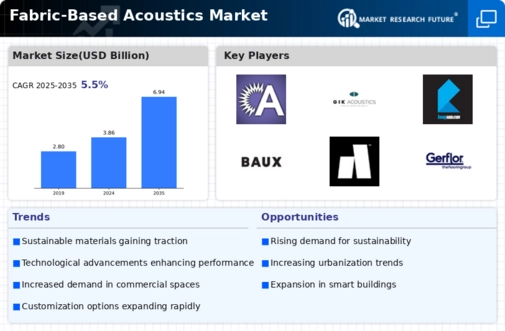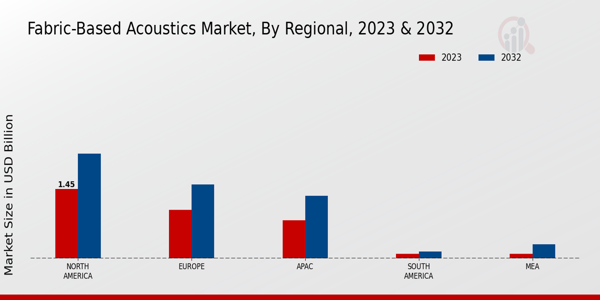Market Growth Projections
The Global Fabric-Based Acoustics Market Industry is projected to experience substantial growth over the next decade. With an expected market size of 3.86 USD Billion in 2024, the industry is on a trajectory towards reaching 6.94 USD Billion by 2035. This growth reflects a compound annual growth rate of 5.48% from 2025 to 2035, driven by various factors such as increasing urbanization, technological advancements, and heightened awareness of acoustic comfort. The market's expansion is indicative of a broader trend towards prioritizing sound management in various environments, suggesting a robust future for fabric-based acoustic solutions.
Rising Awareness of Acoustic Comfort
The rising awareness of acoustic comfort among consumers and businesses significantly influences the Global Fabric-Based Acoustics Market Industry. As individuals become more conscious of the impact of noise on their quality of life, demand for effective acoustic solutions increases. This awareness is particularly pronounced in sectors such as hospitality, education, and healthcare, where sound management is critical for enhancing experiences and outcomes. The market's growth trajectory is supported by the anticipated compound annual growth rate of 5.48% from 2025 to 2035, indicating a sustained interest in fabric-based acoustics as a viable solution for improving sound environments.
Growing Demand for Acoustic Solutions
The Global Fabric-Based Acoustics Market Industry experiences a surge in demand for effective acoustic solutions across various sectors, including residential, commercial, and industrial applications. As urbanization accelerates, the need for soundproofing and noise reduction becomes increasingly critical. For instance, the market is projected to reach 3.86 USD Billion in 2024, reflecting a growing awareness of the importance of acoustics in enhancing comfort and productivity. This trend is particularly evident in open office spaces and educational institutions, where noise control is essential for improving focus and learning outcomes. The emphasis on creating quieter environments is likely to drive further innovation in fabric-based acoustic materials.
Sustainability and Eco-Friendly Materials
Sustainability emerges as a pivotal driver in the Global Fabric-Based Acoustics Market Industry, as consumers and businesses alike prioritize eco-friendly materials. The shift towards sustainable construction practices encourages the use of recycled and biodegradable fabrics in acoustic solutions. This trend aligns with global efforts to reduce environmental impact, as seen in various green building certifications. Companies are increasingly adopting sustainable practices, which not only enhance their brand image but also meet regulatory requirements. As a result, the market is expected to witness a significant increase in the adoption of sustainable fabric-based acoustics, contributing to a projected growth to 6.94 USD Billion by 2035.
Regulatory Support for Noise Control Measures
Regulatory frameworks increasingly support noise control measures, significantly impacting the Global Fabric-Based Acoustics Market Industry. Governments worldwide are implementing stricter noise regulations, particularly in urban areas, to mitigate the effects of noise pollution on public health and well-being. This regulatory environment encourages the adoption of fabric-based acoustic solutions in both new constructions and renovations. For example, building codes may mandate specific sound insulation standards, prompting architects and builders to incorporate advanced acoustic materials. As a result, the market is poised for growth, driven by compliance with these regulations and the growing recognition of the importance of acoustic comfort.
Technological Advancements in Acoustic Materials
Technological advancements play a crucial role in shaping the Global Fabric-Based Acoustics Market Industry. Innovations in material science lead to the development of high-performance fabrics that offer superior sound absorption and aesthetic appeal. For instance, the integration of nanotechnology in fabric production enhances acoustic properties while maintaining lightweight characteristics. This evolution allows for more versatile applications in various environments, from theaters to corporate offices. As manufacturers continue to invest in research and development, the market is likely to benefit from enhanced product offerings, which could further stimulate growth and adoption rates in the coming years.












